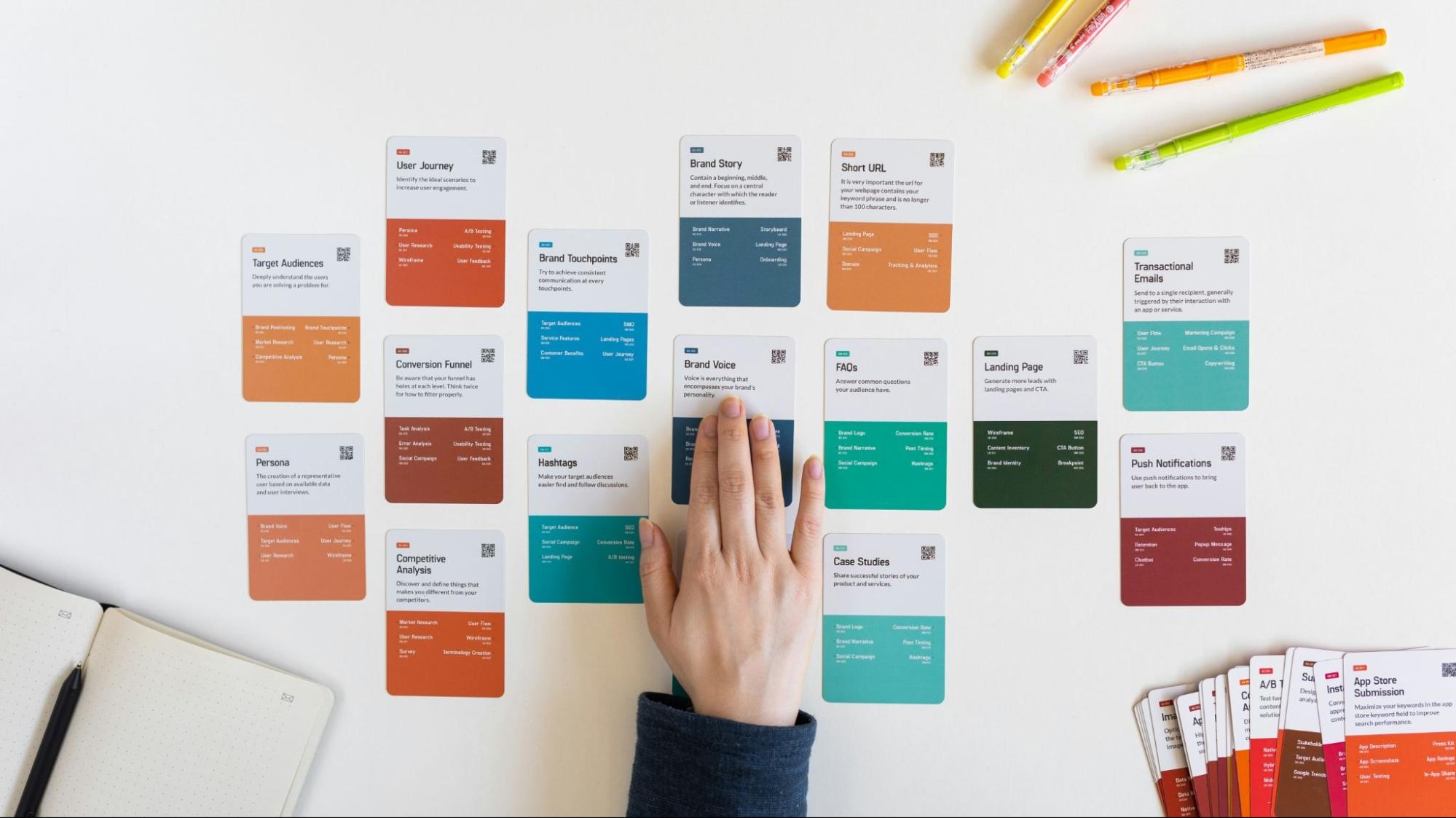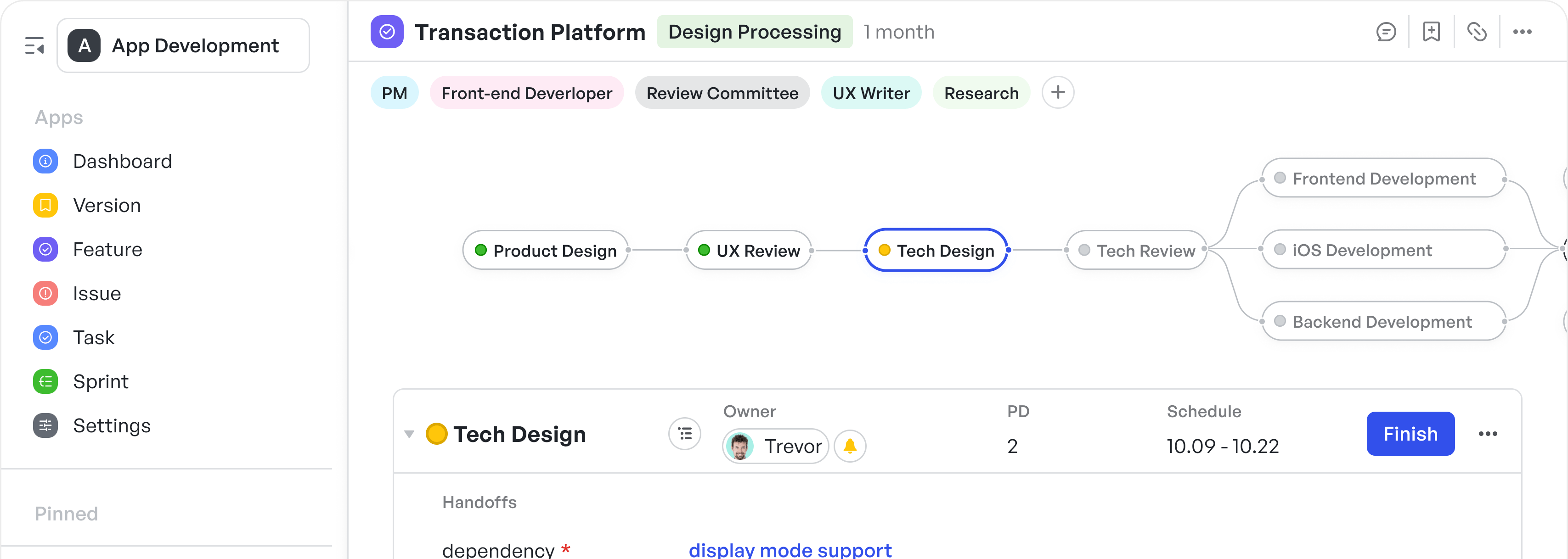Organizations that excel at project management see a 92% project completion rate. While this stat is encouraging, 85% of project managers have to balance multiple projects and come up with tailored approaches for every one of them — a Herculean task.
That calls for speed, precision, and adaptability. In this article, we’ll explore how you can use project management tools to ensure success for every client you work with within your organization.
Meegle helps you do this with its node-driven workflow system. Unlike traditional tools, Meegle allows you to visualize complex processes as interconnected nodes, mirroring the actual flow of project deliverables in software development, digital marketing, and product management.

250px|700px|reset
What is Project Management?
Project management with Meegle revolves around its core feature: the customizable workflow. For instance, a software development team can create a workflow that includes nodes for 'Feature Ideation', 'Design Review', 'Sprint Planning', 'Development', 'QA', and 'Deployment'. Each node connects to others via input and output ports, creating a clear path of dependencies.
In practice, this looks like:
- Planning: The product manager creates user stories in the 'Feature Ideation' node.
- Execution: Developers move tasks through 'Sprint Planning' to 'Development' nodes.
- Monitoring: QA testers track bugs in the 'QA' node, with automatic notifications to developers.
- Closure: The 'Deployment' node triggers automated release processes and collects metrics.
This structure allows for real-time adjustments to project objectives. If a critical bug appears during QA, it can be quickly routed back to development, with all affected team members automatically notified.
Why is Project Management Important?
Simply put, it helps you avoid miscommunication, allocate resources effectively, create a system that can be easily tweaked according to changes in a client’s demands, and gives you handy metrics that show you what you need to work on.
250px|700px|reset
加载中,请稍后
Let’s look at how Meegle's approach to project management directly addresses common pitfalls in digital projects:
1. Miscommunication: Meegle's visual workflows reduce misunderstandings. You can use Meegle to coordinate a product launch campaign across social media, email, and web platforms. The clear dependency chain between content creation, approval, and scheduling nodes will result in a reduction in missed deadlines.
2. Resource Allocation: Meegle's workload management feature allows you to see team capacity at a glance. Say you run a game development studio. You can use this to balance artist workloads across multiple projects, reducing overtime while still meeting release dates.
3. Adaptability: Meegle's node system allows for quick process changes. If a fintech company needs to add a new compliance review step to their development process, they can simply add a new node and reroute the workflow. And they can implement this change in hours, not days.
4. Metrics and Reporting: Meegle's dashboard templates offer instant insights. A SaaS company can use these to track sprint velocities, bug rates, and feature completion times, improving prediction accuracy for project timelines.
Who Uses Project Management?
Project management focuses on many industries, each with its unique challenges and requirements:
- In the IT and software development sector, project managers manage complex software lifecycles. They coordinate teams of developers, designers, and quality assurance specialists to deliver products on time and within scope.
For instance, a project manager at a tech startup might use Meegle's Agile Development template to track sprint progress, manage backlog items, and visualize the entire product roadmap from initial concept to final release.
- Digital marketing agencies rely heavily on project management to coordinate multi-channel campaigns. A marketing project manager might leverage Meegle's Kanban boards to track the status of various content pieces, from blog posts to social media assets. They use the platform's scheduling features to align campaign launches across different platforms, ensuring a cohesive brand message.
- In healthcare, project management techniques play a crucial role in patient care improvement initiatives and research projects.
For example, a hospital administrator might use Meegle's Gantt charts to plan and execute a new patient intake process, coordinating between various departments like admissions, nursing, and IT to ensure a smooth implementation.
- The construction industry uses project management to oversee building projects from design to completion.
A construction project manager might utilize Meegle's tree view to break down a large-scale building project into manageable phases, tracking everything from processes, methods, skills, knowledge, initial site surveys to final inspections.
Across these industries, various roles benefit from project management skills:
- Project management professionals are the primary users, directing overall project execution. They rely on Meegle's comprehensive dashboard to get a bird's-eye view of project health, resource allocation, and upcoming milestones.
- Product managers guide product development, using Meegle's customizable workflows to map out product features, prioritize backlog items, and track market feedback for future iterations.
- Developers manage code releases and sprints, often using Meegle's integration features to sync with version control systems and automate status updates based on code commits.
- Marketers plan and execute campaigns, leveraging Meegle's timeline features to coordinate launch dates, track content creation progress, and measure campaign performance metrics.
Meegle caters to these diverse industries and roles with its flexible platform.
- For software teams, as mentioned before, the Agile Development template offers pre-configured workflows for sprint planning and backlog management.
- Marketers can also utilize the Campaign Management template, which includes stages for ideation, content creation, approval, and performance tracking.
Project Management Approaches
The following are popular project management approaches.
Predictive (Waterfall)
The Waterfall methodology is a linear, sequential approach to project management. Its key principles include:
- Detailed upfront planning
- Sequential phases (e.g., requirements, design, implementation, verification, maintenance)
- Clear deliverables at the end of each phase
This approach is best suited for projects with well-defined requirements and minimal expected changes, such as construction projects or manufacturing processes.
Adaptive (Agile)
Agile methodology is an iterative, flexible approach to project management. Its key principles include:
- Iterative development cycles (sprints)
- Frequent customer feedback and adaptation
- Cross-functional, self-organizing teams
This approach is ideal for software development and projects with evolving requirements or uncertainties.
Hybrid
Hybrid methodology combines elements of both Waterfall and Agile approaches. Its key principles include:
- Using Waterfall for stable, well-defined project components
- Implementing Agile for components with uncertainty or frequent changes
- Flexibility to switch between approaches as needed
This approach is best for large-scale projects that have both fixed and flexible components, such as enterprise software implementations with hardware and software elements.
Six Sigma
Six Sigma is a data-driven methodology focused on process improvement and defect reduction. Its key principles include:
- Define, Measure, Analyze, Improve, Control (DMAIC) process
- Statistical analysis to identify and reduce variability
- Continuous improvement culture
This approach is best for manufacturing, process improvement projects, and any scenario where reducing defects and variability is crucial.
How Does Meegle Play Into This?
Meegle can support all four types of project management approaches. Here's a quick overview of how it helps each of these types:
Predictive(Waterfall)
Meegle's Tree View is a highly effective tool for supporting waterfall project management. This view enables teams to structure projects in a clear, top-down hierarchy, aligning with the sequential phases of the waterfall approach.
Agile
Meegle seamlessly supports Agile methodology with its Kanban boards, providing a centralized view of product backlogs and enabling effective sprint organization for agile development. Teams can visualize work in progress, limit work in process, and adapt swiftly to changing priorities.
For instance, a software development team might manage their two-week sprints on Meegle's Kanban board, moving user stories through "Backlog," "In Progress," and "Done" columns to maintain clear visibility of progress.
250px|700px|reset
加载中,请稍后
Manage your project with a Kanban board
Additionally, Meegle's workflow automation streamlines daily stand-ups by automatically notifying team members of their daily tasks, fostering efficiency and alignment across the team
Hybrid
Meegle supports hybrid methodologies through its customizable workflows and Tree View.
250px|700px|reset
加载中,请稍后
A customizable workflow on Meegle
A project manager could set up a high-level Waterfall structure for the overall project using the tree view, while individual teams use Agile boards for their specific components.
250px|700px|reset
加载中,请稍后
The tree view on Meegle
For example, in an ERP implementation project, the hardware installation might follow a Waterfall approach, while the software customization uses Agile sprints.
Six Sigma
Meegle is an effective project management software that supports Six Sigma with its detailed metrics and reporting features, along with customizable fields for quality measures.
250px|700px|reset
加载中,请稍后
A manufacturing team might use Meegle to track defect rates, process cycle times, and improvement initiatives. The platform's dashboards can display key Six Sigma metrics like process capability indices and control charts.
The 5 Phases of Project Management
The following are the 5 phases of project management.
- Initiating
The initiating phase lays the foundation for project success. During this phase, you define the project's scope, objectives, and key stakeholders. You can also conduct feasibility studies and create a project charter.
With Meegle, you can also create custom templates tailored to their specific needs. A marketing agency might develop a "Campaign Launch" template that includes stages for market research, content creation, and performance tracking. This ensures consistency across multiple projects and helps new team members quickly understand the agency's standard process.
- Planning
The planning phase involves creating detailed project plans, including task breakdowns, timelines, resource allocation, and risk management strategies. This phase is critical for setting realistic expectations and preparing for potential challenges.
Meegle's visual workflow creation tool shines in this phase. Project managers can create node-based workflows that represent each stage of the project. For example, a product launch might include nodes for "Market Research," "Product Development," "Quality Assurance," and "Marketing Campaign." Each node can be further broken down into specific tasks.
The platform's customizable fields allow for agile project management. Your teams can add relevant data points to each task or stage. A software project might include fields for "Story Points," "Priority," and "Release Version." This customization ensures that all necessary information is captured and easily accessible throughout the project lifecycle.
250px|700px|reset
加载中,请稍后
- Executing
In the executing phase, the team carries out work according to the project objectives. This involves task completion, resource management, and stakeholder communication.
Meegle kickstarts smooth execution through its task assignment and real-time update features. Team members can be assigned to specific tasks within each workflow node. As they progress, they can update task statuses, add comments, and attach relevant files directly within the platform.
For instance, in a website redesign project, a designer can update the status of the "Homepage Mockup" task from "In Progress" to "Ready for Review." This automatically notifies the project manager and the next person in the workflow, ensuring seamless handoffs between team members.
- Monitoring
The monitoring and controlling phase involves tracking project progress, comparing it to the original plan, and making necessary adjustments. This phase runs concurrently with the executing phase.
With Meegle, project managers can create custom dashboards that display KPIs in real-time. For a software development project, this might include a burndown chart showing sprint progress, a pie chart of open vs. closed issues, and a timeline of upcoming milestones.
The platform's Gantt chart feature allows managers to visualize the project timeline and quickly identify any tasks that are behind schedule. If delays are detected, the workflow can be adjusted directly from the Gantt chart view, with all affected team members automatically notified of the changes.
- Closing
The closing phase involves finalizing all project activities, delivering the final product or service, and conducting a post-project review. This phase is crucial for ensuring client satisfaction and capturing lessons learned for future projects.
Meegle supports the closing phase with project closure checklists and comprehensive reporting tools. A project manager can create a closure checklist that includes items like "Final client approval," "Financial reconciliation," and "Team debrief." As each item is completed, it's marked off in the system, ensuring no crucial closing tasks are overlooked.
The reporting tools allow for in-depth analysis of the completed project. Managers can generate reports on metrics like task completion times, resource utilization, and budget adherence. These insights can be invaluable for improving processes and executing successful projects.
Challenges in Project Management and Solutions
Common challenges in project management include:
1. Scope Creep: This occurs when project scope expands beyond the original plan, often leading to delays and budget overruns.
Meegle Solution: The platform's visual workflow and change management features help control scope creep through the project life cycle. Any proposed changes to the project scope can be clearly documented, with their impact on the timeline and resources immediately visible. This transparency helps stakeholders make informed decisions about scope changes.
2. Resource Constraints: Many projects struggle with limited resources, whether it's personnel, project budget, or time.
Meegle Solution: The workload management feature provides a clear view of team capacity. Managers can see who's overallocated and who has bandwidth, allowing for more effective resource distribution. The platform's time tracking capabilities also help in accurately estimating future resource needs.
3. Communication Issues: Poor communication can lead to misunderstandings, duplicate work, and missed deadlines.
Meegle Solution: By centralizing project information and communication, Meegle significantly reduces communication gaps. The comment feature on tasks allows for contextual discussions, while the @mention functionality ensures important messages reach the right people. Automated notifications keep all stakeholders informed of relevant updates without overwhelming them with unnecessary information. You can also utilize Meegle’s messaging features.
250px|700px|reset
加载中,请稍后
4. Stakeholder Management: Keeping all stakeholders aligned and informed throughout the project can be difficult.
Meegle Solution: Customizable dashboards and reports can be created for different stakeholder groups, providing them with the specific information they need. The platform's permission settings ensure that stakeholders have appropriate access to project data, maintaining security while promoting transparency.
How Meegle Simplifies Project Management Workflows
Meegle's features transform traditional project management approaches, offering a more intuitive and efficient way to handle a complex project successfully. Here's how Meegle enhances project management workflows.
- Visual-first Approach for Simplified Task Tracking
- Visual-first Approach for Simplified Task Tracking
250px|700px|reset
加载中,请稍后
Meegle’s node-based visual workflow
Meegle's node-based visual workflow system provides an at-a-glance understanding of project progress. Team members can instantly see where tasks are in the process, identify bottlenecks, and understand dependencies between different stages.
This visual approach is particularly powerful for complex project management processes. A marketing campaign with multiple channels (social media, email, content marketing) can be represented as interconnected workflows, allowing managers to see how delays in content creation might impact social media scheduling or email deployments.
- Real-time Collaboration Tools
- Real-time Collaboration Tools
Collaborate through features like in-context commenting, @mentions, and shared document repositories. For example, a designer working on a website mockup can attach the design file directly to the relevant task, tag the project manager for review, and discuss feedback within the platform. This eliminates the need for scattered email threads or separate chat applications, keeping all project-related communication in one place.
The platform's real-time updates ensure that all team members are working with the most current information. When a developer marks a bug as "fixed," the QA tester is instantly notified and can begin verification.
- Customization Options for Workflows and Fields
- Customization Options for Workflows and Fields
Meegle's flexibility allows teams to tailor the platform to their specific needs. A construction project might add custom fields for "Safety Compliance" and "Permit Status" to each task, while a software project could include fields for "Story Points" and "Release Version."
250px|700px|reset
加载中,请稍后
Workflows can be customized to match exact business processes. An e-commerce company launching a new product line could create a workflow that includes stages for product sourcing, inventory management, website updates, and marketing campaign execution, all interconnected to reflect their unique launch process. Another client could need a lean project management approach.
- Integration Capabilities
- Integration Capabilities
Meegle's ability to integrate with other tools enhances its power. For example, integration with version control systems like Git allows for automatic task status updates based on code commits. A task in Meegle could automatically move from "In Progress" to "Ready for Review" when a developer pushes code to a specific branch.
Integration with communication tools like Slack ensures that important project updates reach team members on their preferred platforms. Critical deadline reminders or urgent issue notifications can be sent directly to a team's Slack channel, increasing visibility and response times.
- Automation Features for Repetitive Tasks
- Automation Features for Repetitive Tasks
Meegle's automation capabilities handle routine tasks. In an editorial workflow, for instance, when a writer marks an article as "Ready for Editing," Meegle can automatically assign it to the next available editor and send a notification. This reduces manual handoffs and minimizes the risk of tasks falling through the cracks.
250px|700px|reset
加载中,请稍后
For recurring projects, like monthly financial reports, Meegle can automatically create a new project plan each month, populate it with standard tasks, and assign it to the appropriate team members. This ensures consistency in the process and saves significant setup time for regular activities.
- Cross-functional Team Management
- Cross-functional Team Management
Meegle excels at managing projects that span multiple departments or teams. Its role-based access controls and customizable views allow each team to see the information most relevant to them while still maintaining a cohesive overall project structure.
The project manager can switch between these views or use a high-level dashboard that combines key metrics from all project teams, for effective coordination across the entire project.
Manage Projects with Meegle
As the project phase becomes increasingly intricate and teams more distributed, the need for robust, flexible project management tools has never been greater.
Modern tools like Meegle represent a significant leap forward in project management capabilities. By offering visual workflows, real-time collaboration, customization options, integrations, and automation, these platforms address many of the traditional pain points in project management. They allow teams to adapt quickly to changes, maintain clear communication, and make data-driven decisions.
Remember that the right tool should not just help you manage tasks, but should empower your team to work smarter, collaborate more effectively, and deliver exceptional results.





